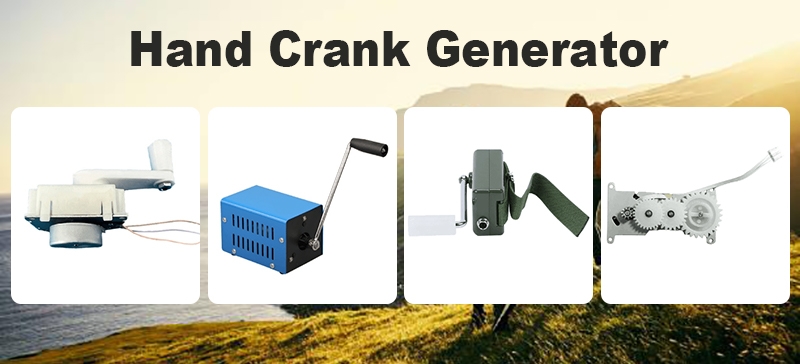Hand crank generators are simple yet powerful devices that convert mechanical energy into electrical energy through human effort. In a world increasingly dependent on electricity, these generators provide a sustainable and off-grid power solution. Whether for emergency use, outdoor activities, or educational purposes, hand crank generators offer a unique method of generating electricity without relying on the grid or conventional power sources.
Introduction to Hand Crank Generators
A hand crank generator is a mechanical device that generates electrical energy by using a hand-operated crank to drive the internal components of the generator. This process involves converting human effort into power that can be used for various applications, from powering small devices like flashlights and radios to providing emergency backup power.
While today’s world is powered by complex electrical grids, there are times when access to conventional power sources is unavailable, such as during power outages, remote outdoor activities, or in off-grid environments. In such situations, hand crank generators serve as a reliable alternative, offering a renewable and portable energy source. Next, Power Home will show you how a hand cranked generator works!

The Basic Principle of Operation
The operation of a hand crank generator relies on the principle of electromagnetic induction, which was discovered by Michael Faraday in the 19th century. The process involves converting mechanical energy into electrical energy using a magnetic field.
Here’s how it works:
- Cranking the Handle: The user rotates the crank manually. This mechanical effort, often in the form of a repetitive motion, generates movement inside the generator.
- Rotor and Stator Interaction: Inside the generator, there is a rotating part called the rotor and a stationary part known as the stator. The rotor is attached to the crank and is typically surrounded by a coil of wire. As the user turns the crank, it causes the rotor to spin.
- Electromagnetic Induction: As the rotor spins within the magnetic field of the stator, it induces an electric current in the coil. This is the core process of electromagnetic induction, where the motion of the rotor creates a change in the magnetic field, causing electrons to move in the conductor (wire) and generate an electrical current.
- Rectification and Storage: In most hand crank generators, the produced current is direct current (DC). To make the electricity usable for various devices, the DC can be stored in a battery for later use or used immediately to power low-energy devices. A rectifier circuit may be used to convert the current into a more usable form if needed.
This simple yet effective process transforms physical effort into an electrical output that powers essential devices. However, the electricity generated is relatively small and limited in output compared to modern power grids.
Types of Hand Crank Generators
Hand crank generators come in a variety of sizes and configurations, each suited for different applications. They are designed based on the amount of power required and the portability needed. Here are some common types:
- Portable Hand Crank Generators: These are the most common types of hand crank generators. They are compact, lightweight, and designed to power small electronic devices such as flashlights, radios, smartphones, or GPS devices. Their portability makes them ideal for use during outdoor activities like hiking, camping, and backpacking.

- Larger Hand Crank Generators: These models are more robust and capable of producing higher amounts of electricity. Larger hand crank generators can power small appliances or be used in off-grid living environments. They often come with a larger crank mechanism and may require more physical effort to operate, but they are suitable for heavier duty applications, such as providing backup power for lights or charging multiple devices.
- DIY Hand Crank Generators: Many people build their own hand crank generators, particularly for educational purposes or as part of DIY energy projects. These devices are often built from simple materials, allowing individuals to better understand the principles of energy conversion and renewable energy. These homemade generators are also useful for demonstrating the process of generating electricity from mechanical energy.
Applications of Hand Crank Generators
Hand crank generators are versatile tools with a variety of applications, from emergency preparedness to education and recreation. Here are some key areas where they are used:
- Emergency Power: Hand crank generators are an excellent backup power source during power outages. In situations where electricity is unavailable due to storms, natural disasters, or other unforeseen events, these generators provide a reliable source of energy to power essential devices like radios, flashlights, medical equipment, or communication devices. Their portability and simplicity make them an ideal choice for emergency kits.
- Outdoor Activities: For campers, hikers, and adventurers, hand crank generators offer a lightweight and self-sufficient way to stay powered while exploring remote areas. Whether you need to charge your phone, power a lantern, or keep your GPS running, a hand crank generator ensures you have energy when no other power source is available.
- Educational Purposes: Hand crank generators are commonly used in schools and educational workshops to demonstrate the principles of energy conversion, electromagnetic induction, and renewable energy. Students can experience firsthand how mechanical energy is transformed into electrical energy, making the learning process interactive and engaging.
- Low-Power Devices: Hand crank generators are ideal for low-power devices, such as LED lights, small fans, or radios. They are often used in places where conventional power sources are scarce or unreliable. The generators can provide enough power to keep small devices operational for extended periods without needing a connection to the electrical grid.
Whether it's for emergencies, outdoor activities, educational purposes or low-power applications, understanding how a hand-cranked generator works can be a big help in real-world use.
(1).png)
(1).png)